
sE Gemini II Review
Sunday, August 1st, 2010 | by matthew mcglynn
We had an  SE Electronics Gemini II in for testing earlier this year. We checked it out on vocals, nylon and steel-stringed acoustic guitar, drums, and more. Here is our review.
SE Electronics Gemini II in for testing earlier this year. We checked it out on vocals, nylon and steel-stringed acoustic guitar, drums, and more. Here is our review.
The Gemini II is remarkable for its topology — it is one of a handful of dual-tube condenser mics on the market. Where most mics use a transformer or transistors on the output circuit, the Gemini II uses a second dual-triode tube. Click the image at right to see the Gemini II profile in the Mic Database, including a fuller description of the features, specifications, photos, and a buyer’s guide pointing out the lowest online prices for the mic.
The “II” is a second-generation design; two features that are new to this edition are the pad and high-pass filter to the mic. Circuitry changes lower the self-noise on the II from 18dBA to an impressively quiet 12dBA.
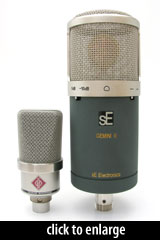 The Gemini II is also remarkable for its physical heft. Just for fun, we shot a photo of the mic next to an surprisingly diminutive mic, the TLM 102. Great sound, it turns out, comes in all shapes and sizes.
The Gemini II is also remarkable for its physical heft. Just for fun, we shot a photo of the mic next to an surprisingly diminutive mic, the TLM 102. Great sound, it turns out, comes in all shapes and sizes.
The success of the Gemini II has lead to the recent expansion of the Gemini product line; check out these 2010 models:
- Gemini III – a limited-edition multipattern version of the Gemini II
- Gemini 3500 – oddly, a FET mic, with the Gemini capsule
- Gemini 5 – a unique hybrid mic with two separate amplifier circuits, switchable between tube/transformer and FET/transformer.
Initial impressions
 The Gemini II is a heavy mic, and is packaged accordingly — in a foam-lined briefcase that is as formidable as the mic itself. A metal shockmount is included, as are extra elastic bands.
The Gemini II is a heavy mic, and is packaged accordingly — in a foam-lined briefcase that is as formidable as the mic itself. A metal shockmount is included, as are extra elastic bands.
The mic is encased in a wooden box, which although beautifully built adds weight and expense to a kit that doesn’t benefit from either. I would prefer if mic vendors would sell the boxes as accessories.
An 8-pin cable for the mic is included, as well as the electrical supply cable for the power supply.
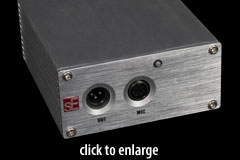 The PSU has a simple, brushed-metal exterior. There are no knobs or switches — the pad and HPF switches are on the microphone itself, and there is no pattern control (see the new Gemini III for that).
The PSU has a simple, brushed-metal exterior. There are no knobs or switches — the pad and HPF switches are on the microphone itself, and there is no pattern control (see the new Gemini III for that).
Overall, the build quality is excellent. Parts fit well. The shockmount works as advertised. This is a classy piece of equipment.
Test 1: Vocals
 Michael Capella and I recorded handful of samples for comparison purposes.
Michael Capella and I recorded handful of samples for comparison purposes.
We recorded four vocal performances over an existing track of acoustic guitar. The signal chain was the same for each mic:
mic -> Digi 002 Rack (stock) -> Pro Tools (24 bit, 44.1 kHz)
All pads and filters on the mics were disengaged, but the HPF on the Digi 002 preamp channel was engaged: -12 dB/octave @ 75Hz.
We used a pop filter in front of every microphone, and a RealTraps PVB behind. Every mic used its own shockmount.
The tracks below were gain-matched in Pro Tools, then output via my BLA-modded Digi 002 to 24-bit WAVs that were subsequently downsampled, dithered, and converted to 320-kbps MP3s in Peak Pro.
Artist: Michael Capella
Song: “Here in the Lonely Night”
Mic: SE Electronics Gemini II
Vocals: Gemini II
Mic: MXL Revelation
Vocals: Revelation
Mic: Shure KSM44
Vocals: KSM44
Mic: sE 4400a
Vocals: 4400a
[ 24-bit WAVs: Gemini II, Revelation, KSM44, 4400a ]
The KSM44 is the most distinctive sounding, to my ear, but what other reviews called “detail” and “clarity” sounds to me more like an artificial graininess, almost a chorus-y effect on the midrange of the vocal. I found it distracting, although within a mix the additional texture might help a vocal stand out. I did like the high end on the KSM, though.
In a blind test, I picked the two sE mics. I liked the colored but detailed mids on the Gemini II. The 4400a, although it failed to impress in our VO Mic Shootout, surprised me here for presenting warm-sounding mids without losing high-frequency clarity. There’s something about the “ess” sounds on the 4400a that I find too explosive, though.
The Revelation seemed to have less low-end, or less proximity effect than the Gemini II, resulting in a slightly thinner sound. Both these tube mics conveyed a lot of detail, but for Michael’s voice I preferred the Gemini II, which comes across as more intimate.
The listening panel, members of which received unidentified 24-bit WAVs, did not all agree. Harry Gale of Route 44 Studios commented, “The KSM44 was my favorite for clarity and presence.”
Steve Faul of WLIO noted that the Gemini II “noise floor was higher, but not hissy, just a bit of rumble as if the air conditioning kicked on during the session. Overall a slightly dark quality.”
Randy Coppinger liked the Gemini II: “It has a nice presence, and works well on this voice.”
Test 2: Acoustic Guitar
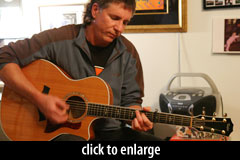 Michael Capella recorded a short guitar passage through most of the same mics. We substituted his go-to acoustic mic, a KSM32, for the KSM44, and included the MXL V89 as a third FET.
Michael Capella recorded a short guitar passage through most of the same mics. We substituted his go-to acoustic mic, a KSM32, for the KSM44, and included the MXL V89 as a third FET.
The signal chain was as described above. We positioned each mic identically — near the 12th fret, pointing toward where the neck meets the body, from a distance of 10-12 inches. We didn’t take the time to find an ideal position for each mic, so you will hear differences in low-frequency response, due in part to proximity effect.
File processing was as described above.
Artist: Michael Capella
Song: “You Go Ahead”
Mic: SE Electronics Gemini II
Guitar: Gemini II
Mic: MXL Revelation
Guitar: Revelation
Mic: MXL V89
Guitar: V89
Mic: Shure KSM32
Guitar: KSM32
Mic: SE Electronics 4400a
Guitar: 4400a
[ 24-bit WAVs: V89, Gemini II, Revelation, KSM32, 4400a ]
I think this test is as much about the listener’s monitoring environment and personal preferences as it is about the sound of the mics. None of the mics exhibited detrimental self-noise. None had brittle highs or obvious distortion. This was a change from my experience in Mike Jasper’s Big Ass Small-Diaphragm Mic Shootout, in which many of the SDCs seemed susceptible to distortion on transients. These large-diaphragm mics handled HF peaks much more cleanly.
After repeated listens through HD650 and HD201 headphones, and HR824 monitors (in a partially-treated room), my picks in a blind test were the V89 and the sE Gemini II. I thought these two were well-balanced, with good string definition and good transient response. The Gemini II seemed to be the most articulate and cleanest of the bunch. The result is interesting, because I initially thought of the Gemini II as a “color” mic, but that’s not necessarily how it acts in session.
I liked the high-end sparkle of the Revelation. Transients seemed a bit softer here, but that may be a performance issue — I think Michael played this pass slightly faster and less aggressively than the others. In any case, the Revelation was a close second place to the V89 and Gemini.
The KSM32 and 4400a seemed too heavy, too bassy. The 4400a seemed to be the more controlled of the two, but I didn’t much like either of them on this guitar, in this position, for this track.
Comments from the listening panel follow. Note that these were all blind auditions of 24-bit WAVs.
Harry Gale
The V89 was my favorite. Hands down more articulate to my ears and overall higher level of likeability.
Steve Faul
There was a wide variety of signature sounds from these mics. In some cases, the choice of one over the other may be simply a matter of where a producer wants the guitar to sit in the mix.
V89: Nice woody quality that didn’t come across too boomy. Some folks might want to EQ the lower end down a bit. This is the first one I heard and it set the bar high for the others.
Revelation: Good string action. Chords ring very clear. Less low end, which would help the guitar cut through a mix. The one I’d chose for a solo.
Gemini II: My mind kept screaming to reposition this mic. I felt like a part of the guitar was missing. Nice strumming action, though.
KSM32: This one had a sweet spot in the lower midrange. This is your choice if you don’t want string scrapes or too much strumming action fighting with the vocal. Otherwise, a bit too cloudy for my taste.
4400a: I didn’t feel like this was a good choice for acoustic guitar. My mind immediately said, “Thank you. Next.” Certain notes phased as if I were listening to an old tape playback with dirty heads.
My pick would be Mic B (Revelation) for “up front” moments or solos, and Mic A (V89) for a full rich sound.
Randy Coppinger
I think all of the guitar recordings would have benefited from some more distance and/or low rolloff, low shelf.
V89: too boomy, very weird mids — don’t like this mic on this guitar at all.
Revelation: kinda boomy, good articulation, too much metal “ping” in the strings
sE Gemini II: well balanced, lows bark out a bit when strummed, distant/roomy
KSM32: full. warm and rich if not dark, heavy but not tubby, most true rendering of mids
4400a: mids sound synthetic, hollow / lacks presence, tight low end
Those of us who picked favorites congregated on the V89, with the Revelation and Gemini II next in line. (Note: the V89 seems to be a steal at $330!)
Test 3: Drums
As much as I dislike recording drums in mono, I only had one Gemini II. I hung it as a mono overhead, next to an inexpensive imported tube mic — the ACM 1200, similar to the Apex 460 or Nady TCM-1150. The most revealing sample was a passage played on the toms.
Mic: TnC ACM-1200
Drums: ACM-1200
Mic: SE Electronics Gemini II
Drums: Gemini II
To be sure, the ACM1200 sounds pretty good here, and considering the price differential would make a great first tube mic for anyone building up a mic locker. This is both the attraction and the curse of cheap imported microphones — they sound pretty good.
In my opinion, the Gemini II wins this comparison easily. Through the Gemini II, the drums have more impact. They sound simultaneously bigger and closer. They have more attack. In contrast, the ACM1200 track sounds veiled and distant.
The Banquet sessions
Darryl Webb put the Gemini against his go-to LDCs at Banquet Studios.
 Darryl sent a pair of clips from a classical guitar session for Gregory Leupp, comparing the Gemini II to the artist’s favorite guitar mic, a Studio Projects C1.
Darryl sent a pair of clips from a classical guitar session for Gregory Leupp, comparing the Gemini II to the artist’s favorite guitar mic, a Studio Projects C1.
Artist: Gregory Leupp
Mic: Studio Projects C1
Gregory Leupp via Studio Projects C1
Mic: SE Electronics Gemini II
Gregory Leupp via Gemini II
[ 24-bit WAVs: Studio Projects C1, Gemini II ]
The C1 is a few dB brighter above 10kHz, and has 5dB more self-noise, but very clean and articulate mids. But I picked the Gemini II in a heartbeat for its warmth and comparative lack of fret noise.
Darryl was also able to use the Gemini II on stand-up bass. The artist is Markie Sanders, performing for a track on an upcoming Kevin Russell release.
Markie Sanders, Bass, Gemini II
Darryl Webb
LOVED the Gemini II.
I am astounded at how quiet it is, especially using two tubes. We have the SE Electronics Z5600 single tube, the SE 5000, and the AKG “The Tube,” and the Gemini was so much quieter. It was warm, vintage sounding with an even response over the frequency spectrum.
I put it up next to an SE 2200aUSB (that we use a lot for vocals and voice-over) and in spoken word, the two sounded almost identical. My theory is that it would have been a different story with singing than with spoken word. Given the price difference between the 2200aUSB [an LDC FET with dual outputs: analog XLR and 16-bit USB] and the Gemini II, if I were buying a selection of mics for a new studio, I would really have to compare those two mics before spending the higher price for the Gemini. That said, I did really like it’s warmth and low noise floor.
The Loudville sessions
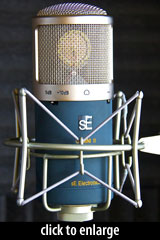 Mathew Trogner and Mark Keller tested the Gemini II against the MXL Revelation and a vintage Telefunken U47. See these shootouts in Mathew’s glorious high-definition videos, posted previously right here:
Mathew Trogner and Mark Keller tested the Gemini II against the MXL Revelation and a vintage Telefunken U47. See these shootouts in Mathew’s glorious high-definition videos, posted previously right here:
To round out the Loudville tracks, here is Mark Keller singing “Turn Back the Hands of Time” into the Gemini II, in a full mix:
Turn Back the Hands of Time (Gemini II on vox)
Here is an a capella excerpt from the same track, through each of the three mics from the shootouts mentioned above — the Revelation, the Gemini II, and the U-47. To see which track is from which mic, click the button below… but only after you listen. 🙂
Microphone 3Mathew Trogner
The Gemini has a unique sound with great character. One thing that was instantly noticeable about it was its upper mid to high frequency boost. After hearing some voiceover using this mic, the warmth in the bottom was also quite apparent.
My first test with this microphone was a female vocalist who sang some harmony parts into it for a track that already had a lead. We went direct into a Mackie board with no EQ or compression. While soloing the part I was worried that the mic had too much “vibe” or “color” for the particular track, but once we laid it in with the rest of the track it mixed in perfectly with almost no EQ. The lead vocal was recorded with a Shure KSM44 and seemed so thin and small in comparison.
My next tests with the microphone involved having Mark Keller from Loudville Studios read some voiceover, play acoustic guitar and also sing. We recorded directly into a Millennia HV-3R straight into Pro Tools. I was surprised to hear it that it was not as noisy as I expected for a mic with two tubes. It sounded great on Mark’s voice and with some compression would fit nicely in a narration. Since the mic does seem to be relatively hyped I could see it being a problem with some voiceover actors or singers who tend to be sibilant. On guitar it was a real champ; it captured the sound beautifully. Afterwards Mark commented how in his headphones and on playback it seemed as though his voice would require almost no EQ. The upper mid boost was very apparent.
Overall everyone during the tests were very pleased with this mic and a few people were surprised that it didn’t cost more money. The mic has a quite a presence. It’s built like a tank. I couldn’t see this being my go-to microphone for everything, but it is a great one to have in the arsenal for many applications.
Conclusions
I liked the Gemini II on just about every source I tried it on.
As a few commenters have noted, it’s not a do-everything utility mic. But its combination of warmth, tone, and articulation make it worth reaching for just in case.
I’ve been watching the price on this mic for a few weeks — this is a lot of microphone for the ~$1050 you can currently buy it for.
Disclaimer
I have no affiliation with sE Electronics or their distributors, and received no compensation for this review. The sE Gemini II was loaned to me for review purposes, and has sadly been returned.
With Gratitude
Thanks to Evan and the gang at Fingerprint Audio for the gear loan, to Mitch Carey and James Young of sE/Sonic Distribution for the support and last-minute product photos, to Mathew Trogner, Mark Keller, and everyone at Loudville Studios, to Darryl Webb and Banquet Studios, to the musicians who contributed their talents to the test process — Michael Capella, Gregory Leupp, Markie Sanders — and to the RecordingHacks Listening Panel: Harry Gale of Route 44 Studio, Randy Coppinger, and Steve Faul of Ohio’s WLIO.
Posted in Microphones, Reviews | No Comments »
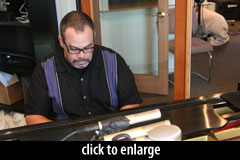
 Telefunken (Neumann) U 47
Telefunken (Neumann) U 47